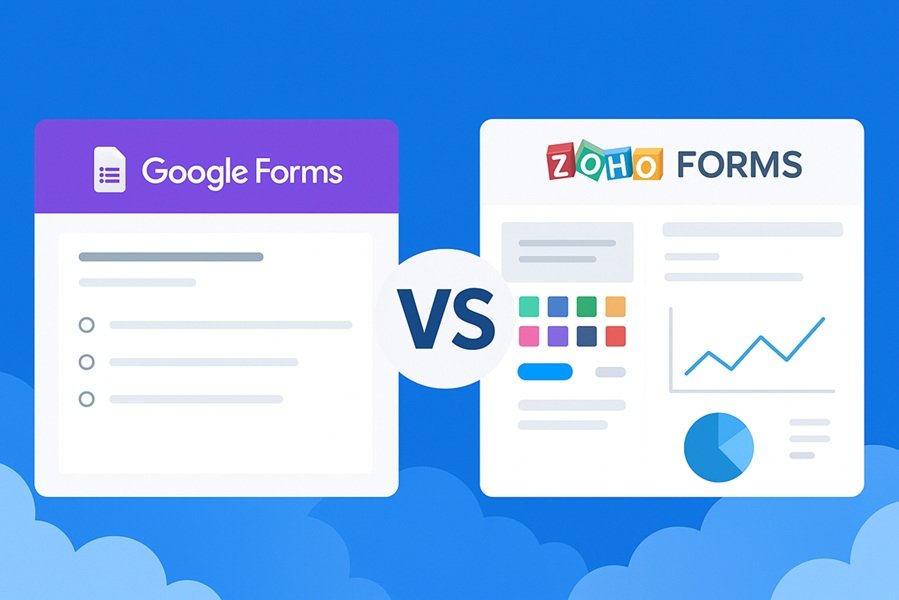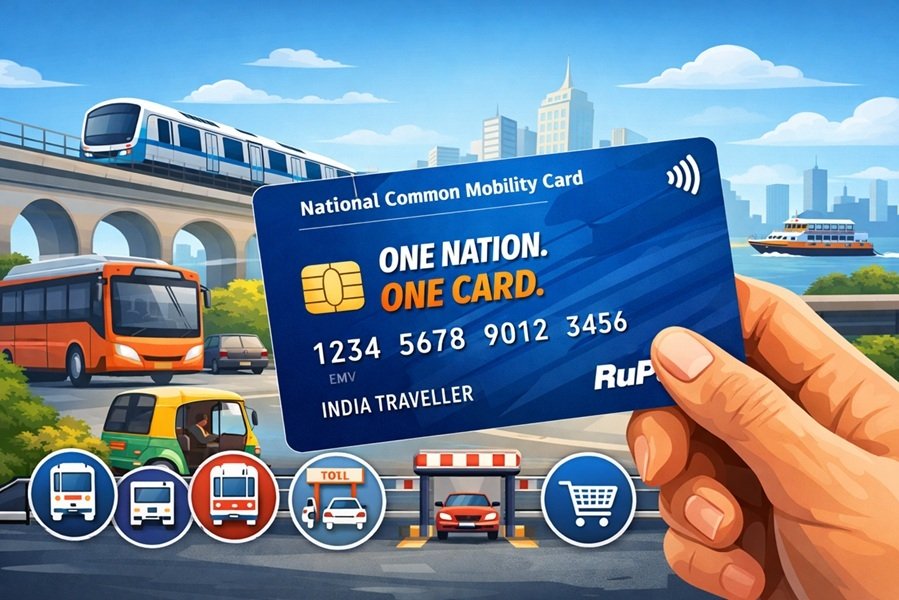
Introduction
Online form builders have become indispensable for collecting feedback, generating leads, and managing workflows. Two of the most popular tools in this space are Zoho Forms and Google Forms. While Google Forms is known for its simplicity and free access, Zoho Forms offers advanced customization, automation, and integration for business users.
In this article, we’ll break down both platforms across multiple dimensions — usability, design, workflow automation, integration, pricing, and scalability — to help you decide which form builder best fits your needs in 2025.
Overview of Zoho Forms and Google Forms
What Is Google Forms?
Google Forms is a free, cloud-based form builder that allows users to create surveys, quizzes, and feedback forms. It’s part of the Google Workspace suite and integrates seamlessly with Google Sheets, Drive, and Gmail. The biggest appeal of Google Forms lies in its simplicity, accessibility, and collaboration features — anyone with a Google account can use it instantly.
What Is Zoho Forms?
Zoho Forms, part of Zoho Corporation’s business software suite, is designed for professionals and organizations that require more than just data collection. It allows custom branding, logic-based workflows, and integration with business tools like Zoho CRM, Zoho Analytics, and Zoho Campaigns. Zoho Forms is ideal for companies that value automation, analytics, and structured data handling.
Read This: Zoho Vani: A New Visual Language for Collaborative Work
Interface and Ease of Use
Google Forms: Minimal and Fast
Google Forms offers a minimal interface where you can add questions, set themes, and share forms within minutes. Its drag-and-drop simplicity appeals to users who want quick results without any learning curve. The platform also supports real-time collaboration, allowing multiple people to edit the same form simultaneously.
Zoho Forms: Powerful Yet Slightly Complex
Zoho Forms features a more detailed interface with additional design, logic, and workflow tools. While it takes a bit longer to master, it provides more flexibility and professional-grade control. The interface supports conditional fields, multi-page layouts, and advanced formatting options, giving businesses a professional touch for client-facing forms.
Customization and Branding
Google Forms
Customization is one of Google Forms’ weak points. Users can change background colors, fonts, and header images, but the overall design remains simple and uniform across all forms. For personal or academic use, this may be sufficient, but for business branding, it can feel restrictive.
Zoho Forms
Zoho Forms excels here. You can apply custom themes, brand logos, background images, and even CSS styling to match your company’s visual identity. Premium users can also host forms on their own domain, creating a seamless experience for website visitors. This makes Zoho Forms an excellent choice for marketing campaigns and customer-facing forms.
Workflow Automation and Logic
Google Forms
While Google Forms allows basic branching (e.g., “Go to section based on answer”), it lacks advanced logic controls. To achieve automated workflows or notifications, users often rely on Google Apps Script or third-party add-ons.
Zoho Forms
Zoho Forms offers built-in conditional logic, multi-step workflows, and approval processes. For example, a submitted form can automatically notify specific teams, trigger email responses, or even update CRM records. This level of automation is ideal for HR departments, sales teams, and customer support operations.
Integration Capabilities
Google Forms
Integration is one of Google Forms’ strong suits — especially within its ecosystem. Responses automatically populate Google Sheets, which can then feed into Data Studio, Apps Script, or Google Analytics. However, native integrations beyond Google’s ecosystem are limited.
Zoho Forms
Zoho Forms connects smoothly with Zoho CRM, Zoho Books, Zoho Desk, and other Zoho applications. It also supports integrations through Zapier, webhooks, and APIs, connecting to third-party platforms like Slack, Trello, or Mailchimp. This makes it perfect for businesses already invested in Zoho’s ecosystem or those needing cross-platform automation.
Reporting and Analytics
Google Forms
Google Forms provides simple summary charts and response graphs. For deeper analysis, you must export responses to Google Sheets. While this approach works well for basic surveys, it’s limited for complex analytics.
Zoho Forms
Zoho Forms includes real-time analytics, detailed reports, and dashboards. Users can filter submissions, calculate metrics, and even integrate data directly with Zoho Analytics for BI-level insights. Businesses conducting customer feedback, lead tracking, or compliance audits will appreciate these advanced capabilities.
Security and Access Control
Google Forms
Google Forms offers standard data encryption and access control via Google accounts. You can restrict responses within your organization or make forms public, but there’s no option for password protection or granular permissions.
Zoho Forms
Zoho provides role-based access control, password-protected forms, and audit trails. It also complies with GDPR and other international data standards. For organizations that handle sensitive client or employee information, Zoho’s security framework offers an extra layer of assurance.
Pricing Comparison
| Feature | Google Forms | Zoho Forms |
|---|---|---|
| Free Plan | Unlimited forms and responses | Free plan with limits on responses and storage |
| Paid Plans | Included with Google Workspace (starts around ₹125/user/month) | Multiple plans starting around ₹500/month with added automation, analytics, and integration features |
| Enterprise Features | Requires Workspace Enterprise tier | Included in higher Zoho tiers with workflow and team collaboration tools |
Verdict on Pricing
For individuals or educators, Google Forms’ free access is unbeatable. However, for business users who require automation, analytics, and branding, Zoho Forms’ paid plans offer better value despite the cost.
Mobile and Offline Functionality
Google Forms
While Google Forms is mobile-friendly in browsers, it lacks a dedicated mobile app or offline data collection support.
Zoho Forms
Zoho Forms has native mobile apps for Android and iOS, allowing users to collect data offline — perfect for field surveys or rural projects. Once connected to the internet, all data automatically syncs to the cloud.
Which One Should You Choose?
Choose Google Forms If You Want:
- A free, easy-to-use tool for quick surveys or registrations
- Simple data collection linked with Google Sheets
- Seamless collaboration with a team using Google Workspace
Choose Zoho Forms If You Need:
- Professional-grade forms with branding and advanced customization
- Workflow automation and approval systems
- Offline data collection and native mobile support
- Integration with Zoho CRM or marketing tools
Final Verdict
Google Forms is the go-to tool for simplicity, speed, and zero-cost use. It’s ideal for students, teachers, and small teams who need to collect information without setup headaches.
Zoho Forms, on the other hand, is built for businesses that value automation, control, and scalability. From lead generation to customer service workflows, it serves as a professional-grade solution that grows with your organization.
In 2025, the choice between the two depends on your purpose:
- For simplicity and speed → Google Forms
- For power, flexibility, and enterprise use → Zoho Forms
Suggested Articles
- What Is Zoho Corporation? India’s SaaS Pioneer Explained
- Zoho Show vs Microsoft PowerPoint: The Complete Comparison for 2025
- Zoho Sheets vs Microsoft Excel: A Detailed Comparison for 2025
- Zoho Writer vs MS Word: A Comprehensive Comparison for 2025
- Zoho Office Suite vs Microsoft Office: A Complete Comparison
- Arattai vs WhatsApp: A Detailed Comparison of Messaging Apps
- Zoho Mail vs Google Mail (Gmail): Detailed Comparison for 2025
- Aadi Vaani: India’s AI-Powered Platform to Preserve Tribal Languages





